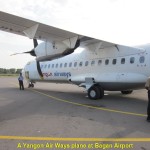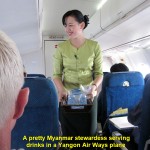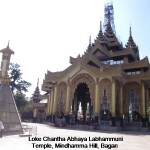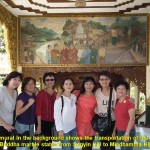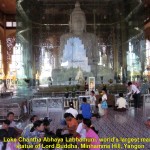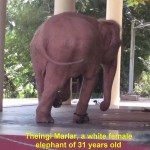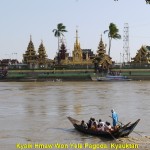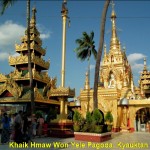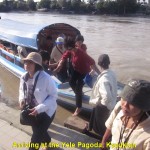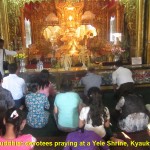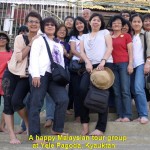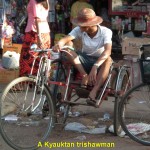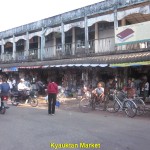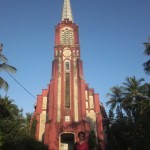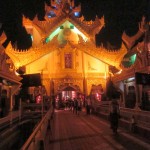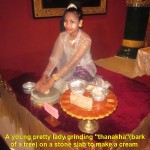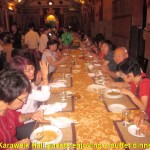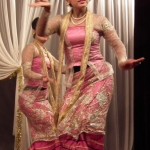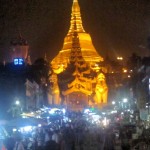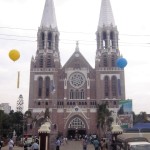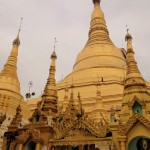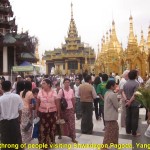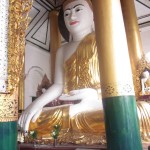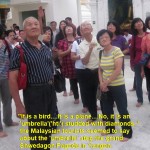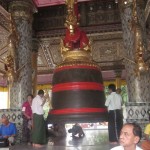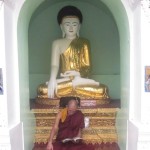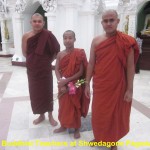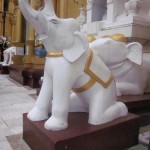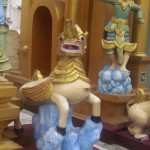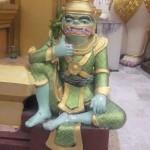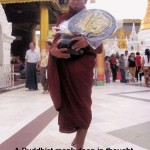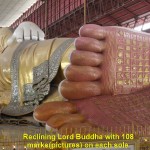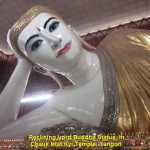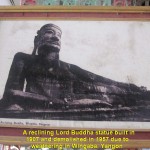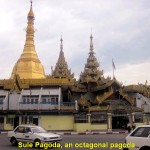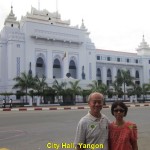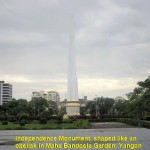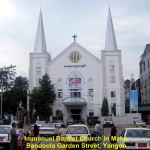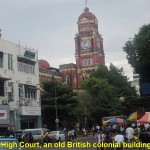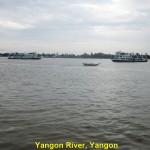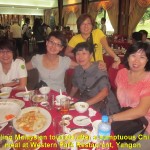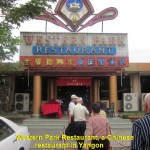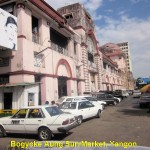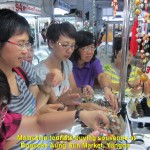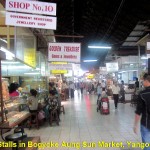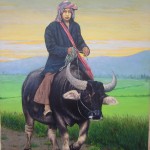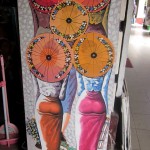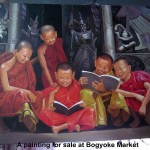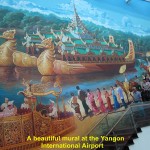Myanmar Travel II
Myanmar Travel II
Day 4 3 December 2011
Loke Chantha Abhaya Labhamuni(Largest Marble Statue of Lord Buddha)
After breakfast at Thaxin Garden Hotel, we left for the Bagan airport and flew by Yangon Airways to Yangon via Mandalay at 8.40 a.m.. On arrival at the Yangon airport at 10 a.m., we went to Mindhamma Hill to see the world’s largest marble statue of Lord Buddha. Known as Loke Chantha Abhaya Labhamuni, its height is 37 feet and weight 600 tons.
We had to donate 200 kyats, if we wanted to use our cameras to snap photos of the statue. It was difficult to get a good photo of it as it was in a large glass case that had reflections of the outside objects.
A stone-sculptor, U Taw Taw, found a large block of white marble in Sagyin Hill which is 21 miles north of Mandalay and donated it to the state. The block was 37 feet long, 24 feet wide and 11 feet thick. Then the state commissioned him and his sons to carve an image of Lord Buddha from the stone in 2000.
When it was partially done, the state took two months to transport it from Sagyin Hill to Mindhamma Hill in Yangon. Later, the statue was completely carved and placed on the hill on 10 August 2000. Since then it has been worshipped by Myanmar Buddhists. Now, it is a tourists’ attraction.
Before we left the hill, a few of us took a photo together with a large mural in the background. It shows Lord Buddha statue being transported from Sagyin Hill to Mindhamma Hill.
White Elephants in Royal Elephant Garden
Our next stop was the Royal Elephant Garden along Mindama Road near the large statue of Lord Buddha. In the garden, we saw two elephants. Theingi Marlar(31 years old) was a small female elephant in light pink and Yaza Gaha(15 years old) a male that was larger but its skin was pink and grey. Their legs were chained and they were moving about, restlessly , in a building with high roof. I was surprised that there was no white elephant to be seen there. Our tour guide then explained to us that an elephant in pink was considered as a white elephant.
According to a Myanmar belief, the appearance of a white elephant is a good omen for the nation as it brings peace, stability and prosperity, prevents dangers and hazards, and helps the nation to enjoy annual bumper harvests of rice. In the olden days, the kings pampered white elephants because they considered them as a symbol of royal power and prosperity.
Myanmar’s Longest Steel Bridge
Having seen the two poor creatures, we left and went to a restaurant, San Chuan Restaurant, for a delicious seafood lunch. After that satisfying meal we made an hour-journey from Yangon to Kyauktan which is 18 miles south-east of Yangon. Before reaching Kyauktan, we had to cross Mayanmar’s longest steel bridge over Yangon River near Thanlyin. Our tour-guide advised us not to take photos of the bridge for state security reasons. We saw some soldiers guarding the bridge and watching us passing by.
The road to Kyauktan was dusty, narrow and winding. We saw pick-up trucks overloaded with passengers. Some of them were standing outside the moving vehicles hanging, dangerously, onto them.
Kyaik Hmaw Won Yele Pagoda(Pagoda in the middle of a river)
Soon we arrived at Kyauktan, a riverine town. We took a ferry to an islet in the middle of Yangon River. Located on the islet was a Buddhist complex of pagodas, shrines and monastery. It was known as Kyaik Hmaw Won Yele Pagoda(Yayle Phaya Pagoda or “Pagoda in the middle of a river”). The first Yele Pagoda was built by King Zeyasana in the 3rd. century B.C.
Giant Catfish
Before we entered the holy place, we had to leave our shoes and socks in the ferry. While entering the holy place, we noticed that it was already crowded with visitors and pilgrims. The worshippers brought flowers, coconuts and bananas and offered them to their god when they prayed. Some visitors and pilgrims at the back of the holy place were seen throwing balls of food into the murky Yangon River. Lots of giant catfish surfaced and swallowed up the floating food which disappeared fast. The food was made of corns and wheat.
Kyauktan Market
Later, we took the same ferry back to the river-bank. Before we disembarked we had to find our shoes and socks in the ferry. When we were on land again, we visited a busy, dirty, old market in Kyauktan. There were shops and hawkers along a few roads leading to the market. Most of them were selling things that were required by local people for their daily needs, such as vegetables, fish, fruits and toiletries.
While walking along a road there, we came across an interesting hawker’s stall. It was selling betel quids, each containing a betel leaf that enclosed a piece of areca nut and some slaked lime. Consumers bought them for chewing. After chewing, they spat it out. Most of them, conveniently, spat onto the roadside and walkway, as the reddish liquid stained many parts of them. While walking along them, we tried not to step on it.
Sacred Heart Catholic Church, Kyauktan
On the way back to Yangon, we stopped at an old Catholic church, Sacred Heart Catholic Church, which is near Kyauktan Town. Built in the 18th. Century by a French missionary, it has an orphanage for boys who have lost their parents to illnesses or the harsh military regime. It is supported by generous foreign donors.
Chinatown in Yangon
It was already evening when we arrived at Yangon. We went to the town centre and visited Chinatown. Most of the Chinese in the city live here. They open up shops that normally sell gold and jewellery, clothes, electronic and electrical products, food, groceries, etc. The most interesting part of this Chinatown is roadside stalls and street vendors displaying their goods that spread onto the heavy traffic road. They sell vegetables, fruits, local and exotic food, clothes, toys, etc. It looks like a street night-market.
Karaweik Hall(Restaurant)
Having seen the busy Chinatown, we went to an unusual restaurant which is built in a shape of a large Mayanmar royal barge at a lake, Lake Kandawgyi. This beautiful golden barge was built in 1972. The restaurant on the barge is known as Karaweik Hall. It serves local, eastern, western and Chinese cuisine.
Before we entered the restaurant, we were well greeted by its smiling workers who were dressed in ancient traditional costumes. While we were in the restaurant we were awe-stricken by the beautiful carvings on the walls and ceilings that made the hall look like a royal dinning hall. Besides, it had a stage where traditional dances were performed for the customers.
As it was a buffet dinner at the restaurant, we savoured as many dishes as our dummies could take them. While sitting at a long table together and enjoying the dishes, we watched a series of traditional dances.
Shwedagon Pagoda at Night
After that splendid buffet dinner in Karaweik Hall, we left and went to a place to see the Myanmar most beautiful pagoda that is called Shwedagon Pagoda. As it was night time, we saw bright lights shinning on the pagoda revealing its golden magnificence from a distance. Then we left for our hotel, Asia Plaza Hotel, and would go back and visit the pagoda on the following morning.
Day 5 Sunday 4 December 2011
St. Mary’s Cathedral, Yangon
Day 5 was our last day of our tour in Myanmar and we had a few more places to visit in Yangon. After breakfast, we planned to visit Shwedagon Pagoda, Myanmar’s largest and most beautiful pagoda. On the way to the pagoda, we stopped for a short while in front of Myanmar’s largest cathedral, St. Mary’s Cathedral., which is in Bo Aung Kyaw Street. As it was not on our itinerary, we stayed on the bus, admired its architecture and watched Catholic followers entering the cathedral to celebrate its 100th. anniversary(1911-2011).
St. Mary’s Cathedral was designed by a Dutch architect, Jos Cuypers, and constructed in the Gothic architectural style under the supervision of Father Janzen, a Dutchman. It was completed in 1899 and dedicated to “Our Lady of Immaculate Conception” in 1911. Its façade consists of two spires and a belltower with a rose window in between them. It can accommodate 1,500 worshippers as its length is 291 feet and width 101 feet.
In 1930, an earthquake caused a little damage to the church, in WWII, the Allied bombing destroyed some stained window glasses and in 2008, the powerful Nargis Cyclone destroyed the window glasses again. This church is now on the Yangon City Heritage List.
Shwedagon Pagoda, Yangon
Then we continued our journey to Shwedagon Pagoda located on Singuttara Hill(51 m). We saw it on the previous night, but from outside.
When we arrived at the Shwedagon Pagoda Lift Tower in the late morning, we had to take off our shoes and socks. Then we took a lift for foreigners only to the second level and walked to the pagoda. Entering its compound, we were mesmerized, completely, by its beauty and immensity. Besides, we were amazed to see lots of people there.
The first Shwedagon Pagoda in Yangon was built over 2500 years ago(588 B.C.) when Lord Buddha was still alive. He gave 9 strands of his hair to two Myanmar’s first Buddhist brothers who visited him in India. When they went back to Yangon they built a 8-metre high pagoda to enshrine them. Since then many new pagodas were built to replace the old ones on the hill. Each time a new one was built, it was higher than the previous one.
The present pagoda was built to a height of 99 metres in the 18th. Century. A Mon queen, Shin Sawbu(1394-1472), was the first person to give gold equivalent to her weight to gild the pagoda. Since then, monarchs and their subjects followed the queen’s example. It is still practised today by generous Myanmar people.
The total weight of the gold that covers the pagoda now is estimated to be about 60 tons. Besides gold, diamonds, rubies, sapphires and other gemstones have been donated by worshippers. These gemstones adorn the upper part of the pagoda, especially the “umbrella” or “hti”. It is surprising to know that Myanmar people are devoted Buddhists and will donate gold and gemstones to beautify the pagoda.
Myanmar Astrology
Surrounding the base of Shwedagon Pagoda are eight mini-statues of Lord Buddha, each has a different animal statue below it. According to Myanmar astrology, the day a person was born determine his planetary post which is marked by an animal, as shown below:
|
Day of Birth |
Planetary Post |
|
Sunday |
Garuda |
|
Monday |
Tiger |
|
Tuesday |
Lion |
|
Wednesday(Morning) |
Tusked Elephant |
|
Wednesday(Afternoon) |
Tuskless Elephant |
|
Thursday |
Mouse |
|
Friday |
Guinea Pig |
|
Saturday |
Dragon/Serpent |
As I walked round the base, I saw people, young and old, pouring water onto Lord Buddha statues and the animal statues(representing the days they were born), praying and making a wish.
Maha Tissada Gandha Bell, Shwedagon Pagoda
Hanging in a beautiful pavilion near the pagoda is a large bell, Maha Tissada Gandha Bell, weighing 42 tons. Donated by King Tharrawarddy in 1841, the bell has 20 kg-gold plating on its upper part. Besides, there are several small pagodas, shrines and rest-halls with Lord Buddha statues around the Shwedagon Pagoda, and they are built close to each other. Painted statues of kneeling elephants, lions, ogres, serpents, spirits, etc. adorned the base of the large magnificent pagoda.
There were monks at the pagoda. Some were meditating in front of Lord Buddha statues and others went there for a visit. But there was one that caught my attention. That monk, deep in thought and holding an almsbowl and new fan, was walking very slowly in an anti-clockwise direction around the pagoda. As he was the only one doing that, I was wondering what his intention was.
Chauk Htat Kyi Temple, Yangon
After spending an hour or so at the Shwedagon Pagoda, we left for another holy place called Chauk Htat Kyi in Wingaba, Yangon. This temple houses a 65 metre long statue of Lord Buddha in a relaxing and reclining position. He is lying on his right side with his head resting on his right palm. This statue shows that Lord Buddha was slim and young. Besides, he had white complexion, bright red lips, eyes with blue eye-shadow and long eye-lashes, and eyebrows that were long, narrow and dark black.
Lord Buddha’s Sole Marks
On each sole of the statue, there are 108 marks which are represented by pictures belonging to 3 groups or “worlds”, viz. animate, inanimate and conditioned. An information-board near the statue says that Lord Buddha was greater than the 3 “worlds” and explains that those marks became apparent right from Lord Buddha’s birth. When 8 out of 108 royal astrologers were asked to comment on the baby’s 108 marks, 7 predicted that the child would either become the Buddha or Cakkavatti(Universal Monarch). Only Sudata Kondamma, the youngest among them, made a single prediction that the royal child was destined to be the Buddha. He gave the reason that the child had an image of Cakkavati on each sole and was a personage superior to Cakkhavatti. So he could only be the Buddha.
The reclining Lord Buddha mentioned above was built in 1966. The original one which looked quite different from the present one was built by a local rich man, Sir Hpo Thar, in 1907. Later, the old statue suffered serious damages due to long exposure to weathering in the open. In 1957, it was demolished and replaced by the present one in 1966.
Colonial Buildings
Having visited the reclining Lord Buddha, we went to the city centre in Kyauktada Township. On arrival, we saw a few landmarks, such as City Hall(in Bo Aung Kyaw Road), Sule Pagoda(in Sule Pagoda Road), Independence Monument(in Mahar Bandoola Garden), High Court(in Pansodan Road)and Immanuel Baptist Church(in Maha Bandoola Garden Street). Some of these buildings, like the City Hall, Main Post Office and High Court were built during the British rule(1824-1948) and their architectures have the British colonial influence.
Yangon River
Then we left the place and went to the Yangon River. It flows from Yangon to the Gulf of Martaban. As it is navigable by ocean-vessels, it plays an important role in the Myanmar economy. Besides, the river is a source of water for rice cultivation.
After half an hour of watching some riverine activities and enjoying the views, we went for lunch at a restaurant, Western Park Restaurant, and were treated to a sumptuous lunch. After that satisfying meal, we went to visit the last place in Yangon City before we left for home in Malaysia.
Bogyoke Aung Sun Market
The place we visited was the largest market in Myanmar. When it was built in 1926, it was named after a British, James George Scott. It was commonly known as Scott Market then. But when Myanmar gained independence in 1948, its name was changed to the name of a Myanmar general, Bogyoke Aung Sun. So the market is known as Bogyoke Aung Sun Market since then. This two storey-market houses a few hundreds of stalls, selling arts, handicrafts, antique, foodstuffs, clothes, jewellery, gemstones, etc.
As some of us in our tour group wanted to buy something for our loved ones and friends back home, we asked our tour-guide, Chan, to recommend souvenirs for them. After an hour of browsing and purchasing at some stalls, we left the well-known market for the Yangon International Airport.
Back Home
Arriving at the airport we thanked and bade farewell to our wonderful tour guide, Chan. Then we checked in at the airport. At 5.15 p.m., we took off on an Air Asia plane bidding farewell to Myanmar, a lovely, friendly but poor country. 2½ hours later, we landed safely at KLIA, Sepang, Malaysia, and were glad to be home again.
Well, that is another travel adventure of mine and I hope you like reading it.
Acknowledgement
My wife and I would like to thank the travel agency, Chia Sin Travel Service Sdn. Bhd., Kluang, Johor, Malaysia, for the excellent services it had provided, including transport, accommodation, and food. We also like to thank our tour-leader, Lina Chua, for taking care of us during the tour. Besides, we would like to thank our experienced, knowledgeable and good-natured Myanmar English-speaking tour guide, Ms. Khin Nyein Chan, the careful Yangon and Bagan bus-drivers and their helpful assistants for making our tour in Myanmar enjoyable and memorable. Last but not least, we would like to thank all our tour members for their friendliness and excellent companionship.
Written by: Choo Chaw, Kluang, Johor, Malaysia

